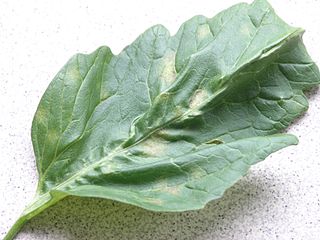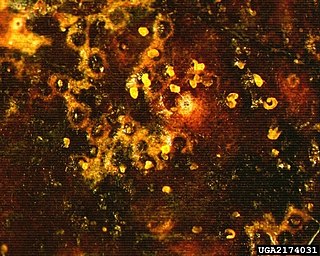
The Pathogen-Host Interactions database (PHI-base) is a biological database that contains manually curated information on genes experimentally proven to affect the outcome of pathogen-host interactions. The database has been maintained by researchers at Rothamsted Research and external collaborators since 2005. PHI-base has been part of the UK node of ELIXIR, the European life-science infrastructure for biological information, since 2016.

Pyrenophora tritici-repentis (teleomorph) and Drechslera tritici-repentis (anamorph) is a necrotrophic plant pathogen of fungal origin, phylum Ascomycota. The pathogen causes a disease originally named yellow spot but now commonly called tan spot, yellow leaf spot, yellow leaf blotch or helminthosporiosis. At least eight races of the pathogen are known to occur based on their virulence on a wheat differential set.
Drechslera wirreganensis is a plant pathogen causing Platyspora Leaf Spot.

Passalora fulva is a fungal plant pathogen that causes tomato leaf mold.

Cochliobolus carbonum is one of more than 40 species of filamentous ascomycetes belonging to the genus Cochliobolus. This pathogen has a worldwide distribution, with reports from Australia, Brazil, Cambodia, Canada, China, Congo, Denmark, Egypt, India, Kenya, New Zealand, Nigeria, Solomon Islands, and the United States. Cochliobolus carbonum is one of the most aggressive members of this genus infecting sorghum, corn and apple. As one of the most devastating pathogens of sweet corn, C. carbonum causes Northern leaf spot and ear rot disease while the asexual stage causes Helminthosporium corn leaf spot. Cochliobolus carbonum is pathogenic to all organs of the corn plant including root, stalk, ear, kernel, and sheath. However, symptoms of infection show distinct manifestations in different plant parts: whole plant - seedling blight affects the whole plant, leaf discoloration and mycelial growth, black fungal spores and lesions appear on inflorescences and glumes, and grain covered with very dark brown to black mycelium which gives a characteristic charcoal appearance due to the production of conidia.
Drechslera dematioidea is a plant pathogen.
Drechslera gigantea is a plant pathogen that causes eyespot disease on many host plants. There are Poa pratensis turfgrass cultivars that are resistant to D. gigantea, although that resistance is not as effective when stressed. In 2020, multilocus sequencing identified this pathogen as a member of the genus Bipolaris and proposed D. gigantea be transferred to Bipolaris gigantea.

Setosphaeria rostrata is a heat tolerant fungus with an asexual reproductive form (anamorph) known as Exserohilum rostratum. This fungus is a common plant pathogen, causing leaf spots as well as crown rot and root rot in grasses. It is also found in soils and on textiles in subtropical and tropical regions. Exserohilum rostratum is one of the 35 Exserohilum species implicated uncommonly as opportunistic pathogens of humans where it is an etiologic agent of sinusitis, keratitis, skin lesions and an often fatal meningoencephalitis. Infections caused by this species are most often seen in regions with hot climates like Israel, India and the southern USA.

Puccinia purpurea is a fungal species and plant pathogen that causes rust on sorghum. It is found in temperate places worldwide, excluding colder parts such as Russia and Canada.
Elsinoe rosarum, Anthracnose, is a fungal plant pathogen. It is a condition found on roses, causing leaves to have irregular dark margins and spots. The disease usually appears during wet weather.

Drechslera avenacea is a fungal plant pathogen.
Drechslera andersenii is a fungus that is a plant pathogen. It was originally found on the leaves of Lolium perenne in Great Britain. It was also found on Italian ryegrass.
Drechslera musae-sapientium is a plant pathogen.

Drechslera is a genus of fungi. Many of the species in this genus are plant pathogens.
Pathogenic fungi are fungi that cause disease in humans or other organisms. Although fungi are eukaryotic, many pathogenic fungi are microorganisms. Approximately 300 fungi are known to be pathogenic to humans; their study is called "medical mycology". Fungal infections kill more people than either tuberculosis or malaria—about 2 million people per year.
Polygalacturonase inhibitor proteins (PGIPs), also known as polygalacturonase-inhibiting proteins, are plant proteins capable of inhibiting the action of polygalacturonase (PG) enzymes produced by bacterial and fungal pathogens. PGs can be produced by pathogens to degrade the polygalacturonan component of plant cell walls. PGIPs are leucine-rich repeat glycoproteins of approximately 360 amino acids in length, and PGIPs may reduce the activity of PGs by one or two orders of magnitude. Both competitive and non-competitive inhibition has been observed for various PGIPs. However, no inhibition of endogenous plant PGs that participate in fruit ripening by PGIPs have been reported.
In biology, a pathogen, in the oldest and broadest sense, is any organism or agent that can produce disease. A pathogen may also be referred to as an infectious agent, or simply a germ.

Exserohilum is a genus of fungi in the family Pleosporaceae. The Exserohilum species are known for causing blight and human immune system diseases. The sexual reproductive states of Exserohilum species are known as Setosphaeria. The type species is Exserohilum turcicum. This genus is among three dematiaceous that are categorized for containing pathogens leading to diseases like phaeohyphomycosis.
Drechslera leaf spot is a fungal disease of turfgrass caused by several species of Drechslera.








